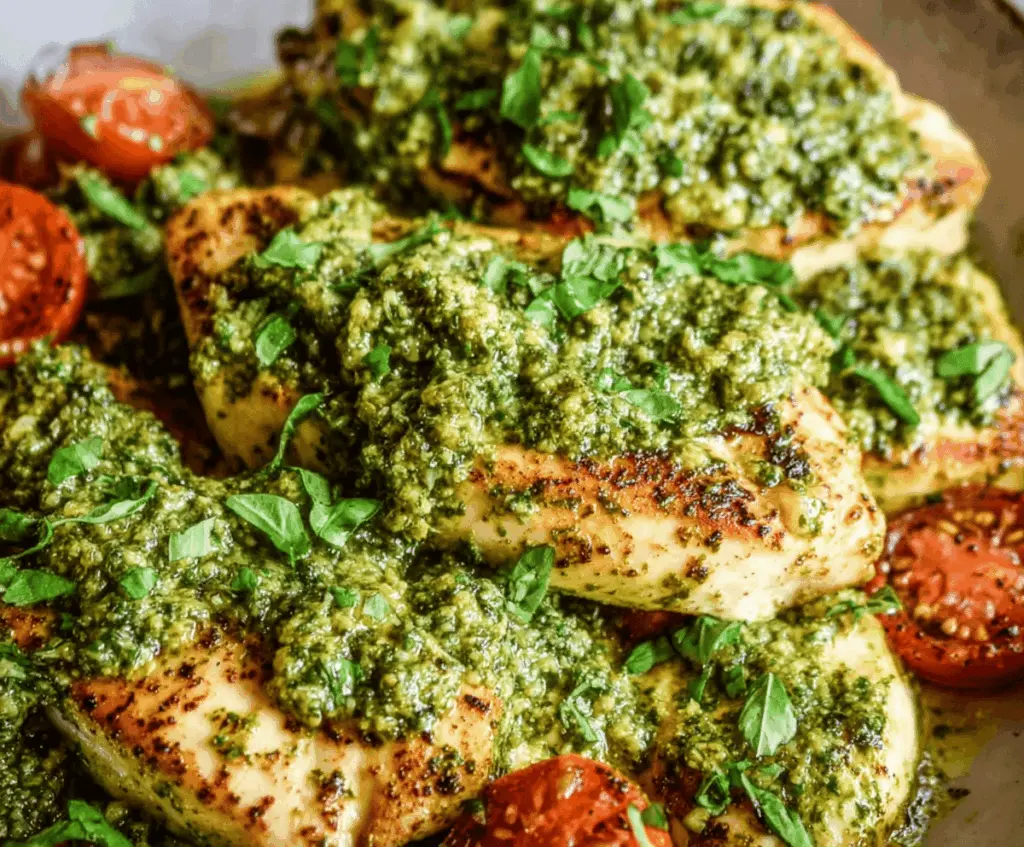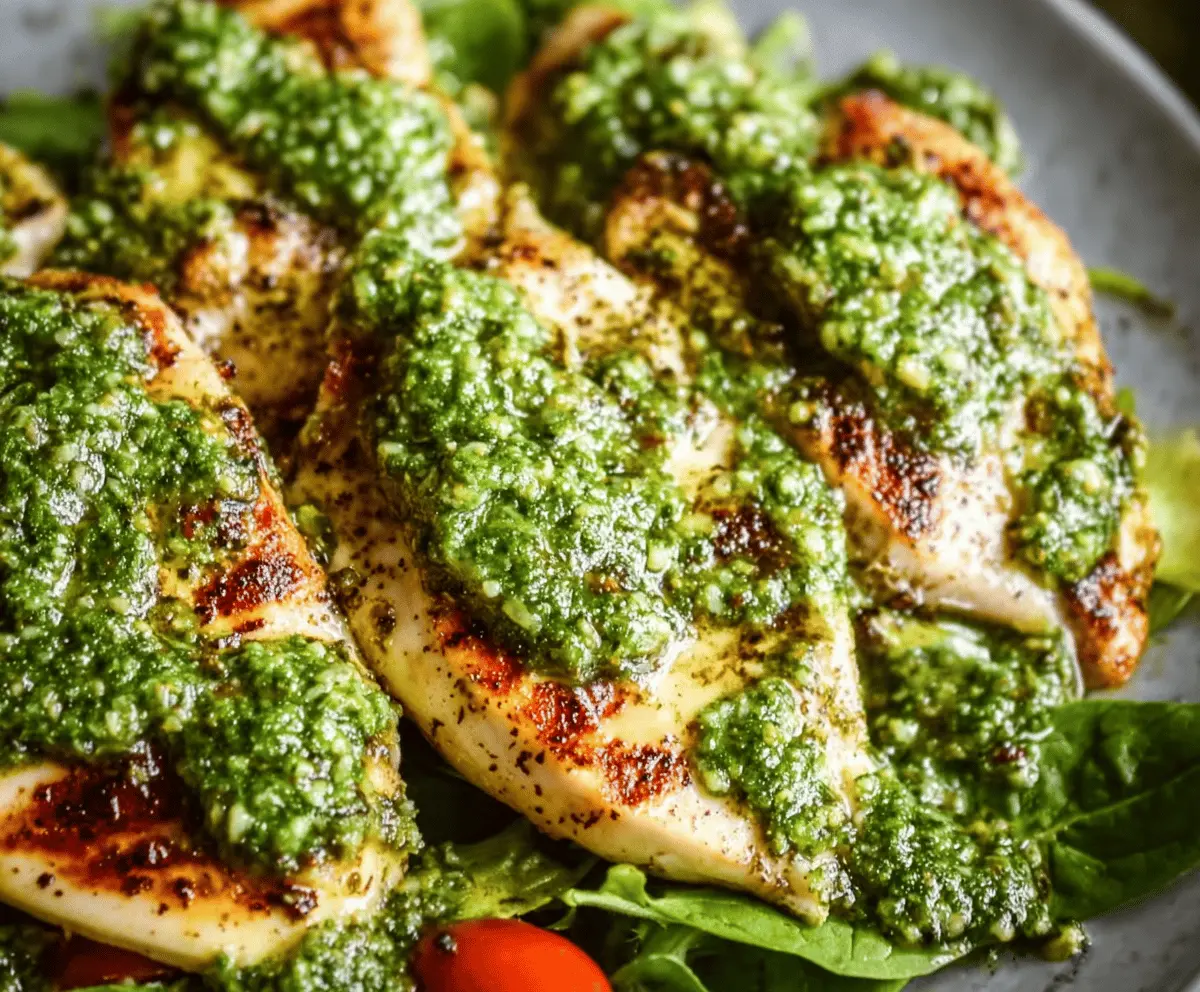
Dairy Free Pesto Chicken
Dairy Free Pesto Chicken is a fresh and flavorful dish that combines tender chicken breasts with bright, herb-packed pesto made without any cheese or cream. This recipe keeps things light…
Tip: save now, cook later.Dairy Free Pesto Chicken is a fresh and flavorful dish that combines tender chicken breasts with bright, herb-packed pesto made without any cheese or cream. This recipe keeps things light but still full of that classic pesto taste, thanks to fresh basil, garlic, nuts, and a hint of lemon. It’s a great way to enjoy all the deliciousness of pesto without worrying about dairy.
I love making this when I want something quick but special. The chicken stays juicy and the dairy-free pesto adds such a lively touch that everyone asks for seconds. I’ve found that using pine nuts or walnuts in the pesto gives it a nice texture that I really enjoy. Plus, swapping the usual Parmesan for nutritional yeast or just leaving it out keeps things simple and easy for those avoiding dairy.
My favorite way to serve this dish is over a bed of barley or quinoa with some roasted veggies on the side. It feels like a perfect weeknight meal that’s healthy but still feels like a treat. Whenever I make it, it fills the kitchen with a fresh, herby smell that always makes me smile. This recipe is definitely one I go back to when I want a tasty and dairy-free dinner everyone will love.

Key Ingredients & Substitutions
Chicken Breasts: I like using boneless, skinless chicken breasts for easy cooking and even flavor absorption. You can swap for chicken thighs if you prefer juicier meat.
Fresh Basil: This is the heart of the pesto. Fresh leaves work best for vibrant flavor. If you’re out, try baby spinach or kale, but the taste will be milder.
Nuts: Pine nuts give pesto a classic taste, but walnuts or almonds are great cheaper alternatives and add nice texture.
Nutritional Yeast: This adds a cheesy note without dairy. Feel free to skip it or use a small amount of vegan cheese as a substitute.
Olive Oil: Use good quality extra virgin olive oil for rich flavor in both the pesto and cooking the chicken.
How Do I Make the Pesto Creamy Without Cheese?
Since this is dairy-free, the secret to creamy pesto is balancing the nuts, olive oil, and garlic:
- Start by pulsing your basil, nuts, garlic, salt, lemon juice, and nutritional yeast (if using) in a food processor.
- Slowly drizzle in olive oil while the machine runs. This helps emulsify the oil into the mixture, creating a creamy texture.
- Don’t over-blend; a little texture is good and makes the pesto feel fresh.
- Taste and adjust seasoning—sometimes a little extra lemon juice brightens everything up.
This method gives you a smooth, tasty pesto that clings beautifully to chicken without needing cheese.
Equipment You’ll Need
- Large skillet – perfect for searing chicken evenly and can hold tomatoes if you add them.
- Food processor or blender – makes quick work of blending fresh basil, nuts, and garlic into smooth pesto.
- Measuring spoons and cups – for accurate ingredient amounts in the pesto and seasoning the chicken.
- Sharp knife and cutting board – to prep chicken and chop fresh herbs for garnish.
Flavor Variations & Add-Ins
- Swap chicken for salmon or tofu for a different protein that pairs nicely with pesto’s bright flavor.
- Add sun-dried tomatoes to the pesto for a tangy, slightly sweet twist that complements the herbs.
- Mix in fresh spinach or kale with the basil in the pesto for added nutrients and a milder taste.
- Toss sliced mushrooms or zucchini in the skillet with the chicken for extra veggies and texture.
Dairy Free Pesto Chicken
Ingredients You’ll Need:
For the Chicken:
- 4 boneless, skinless chicken breasts
- Salt and black pepper, to taste
- 1-2 tablespoons olive oil
- Cherry tomatoes (optional, halved and cooked alongside)
For the Dairy-Free Pesto:
- 2 cups fresh basil leaves, packed
- 1/3 cup nuts (pine nuts or walnuts work well)
- 3 cloves garlic
- 1/2 cup olive oil
- 2 tablespoons nutritional yeast (optional, for cheesy flavor)
- 1 tablespoon fresh lemon juice
- 1/4 teaspoon salt
For Garnish:
- Fresh parsley or basil leaves, chopped
How Much Time Will You Need?
This recipe takes about 10 minutes to prepare and 15 minutes to cook, making it a quick and tasty meal option that’s ready to serve in around 25 minutes total.
Step-by-Step Instructions:
1. Make the Dairy-Free Pesto:
In a food processor or blender, combine the fresh basil leaves, nuts, garlic, nutritional yeast (if using), lemon juice, and salt. Pulse until the ingredients are coarsely chopped. Then, with the processor running, slowly pour in the olive oil until the mixture is smooth but still has some texture. Taste and adjust seasoning as needed. Set aside your fresh pesto.
2. Cook the Chicken:
Season both sides of the chicken breasts with salt and black pepper. Heat 1-2 tablespoons of olive oil in a large skillet over medium-high heat. Add the chicken breasts to the skillet and cook for 5-7 minutes on each side, or until they are golden brown and cooked through (the internal temperature should reach 165°F / 74°C). If you like, add halved cherry tomatoes around the chicken in the pan to soften and cook slightly.
3. Combine and Serve:
Once the chicken is cooked, remove the skillet from the heat. Spoon generous amounts of the dairy-free pesto over each chicken breast. Garnish with freshly chopped parsley or basil leaves. Serve your pesto chicken hot, alongside your favorite roasted or steamed vegetables, or over grains like quinoa or rice for a wholesome meal.
Can I Use Frozen Chicken for This Recipe?
Yes! Just make sure to fully thaw the chicken in the refrigerator overnight before cooking. Pat it dry with paper towels to remove excess moisture, which helps achieve a good sear.
Can I Make the Pesto Ahead of Time?
Absolutely! You can prepare the dairy-free pesto up to 2 days in advance. Store it in an airtight container in the fridge with a thin layer of olive oil on top to prevent browning. Give it a quick stir before using.
How Should I Store Leftover Pesto Chicken?
Place any leftovers in an airtight container and keep them in the refrigerator for up to 3 days. Reheat gently on the stove or in the microwave to avoid drying out the chicken.
What Can I Substitute for Pine Nuts in the Pesto?
Walnuts, almonds, or cashews work well as nut alternatives and still give the pesto a nice texture and flavor. Toasting the nuts lightly before blending can add extra depth.
